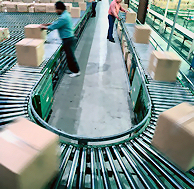 The ultimate supply chain and the ideal control of parts, materials, work in progress and finished goods in manufacturing will be provided by Real Time Locating Systems (RTLS), ultimately with sensing as well.
The ultimate supply chain and the ideal control of parts, materials, work in progress and finished goods in manufacturing will be provided by Real Time Locating Systems (RTLS), ultimately with sensing as well.
These are a form of active RFID and there are various types available from Ultra Wide Band (UWB) which uses a broad range of frequencies in the microwave region, to systems in the megahertz region, though 2.45 GHz is now very popular for RTLS. One form radio fingerprints existing WiFi emissions and another measures Time Delay of Arrival (TDOA) of several emitted beams. The WiFi approach usually calls for more nodes to be installed but infrastructure is usually still low in system cost. G2 Microsystems has provided the most advanced chip for these tags, gaining considerable improvements in cost and power economy. For 3D location of staff and valuable assets in oil refineries, supply depots etc., BP finds RTLS from companies such as Time Domain and Ubisense to be best. Ubisense is delivering value in automotive manufacturing as well with its unusually accurate UWB RTLS.
However, Belgian startup Green Peak favours active RFID on 2.45 GHz ZigBee protocols in indoor locations whereas Axcess International has an alternative approach. Ford has widely used RTLS in manufacturing, including the location and stocktaking of finished vehicles in huge yards, where long range is needed. Indeed, PINC Solutions has an impressive RTLS offering specifically for yard management.
UK startup RFTRAQ has established a commanding position in paper production and newsprint by tagging the huge paper reels with UHF active RFID. The RFTRAQ systems have unusually large two way range of up to 400 meters and the tags can be remotely reconfigured.
Boeing is looking at a variety of approaches, one of which involves a 64 kilobit active tag, an unusually large amount of memory for a disposable tag in manufacturing, the extra capacity is needed to enable considerable rewritability for recording status etc. on very high value and mission critical items.
Identec Solutions has had remarkable success in installing the latest active RFID systems in manufacturing, logistics and allied applications, usually achieving ranges up to 100 meters with UHF. Increasing worker safety has been one objective. Another aspect is the use of active RFID in manufacturing automation and here Pepperl + Fuchs is a respected leader.
The active RFID market in 2012 is summarised below:
The Active RFID Market in 2012 - Source IDTechEx report "Active RFID ands Sensor Networks 2007-2017"
Active RFID will rise to 27% of the total RFID market by value in 2017 and will make a larger percentage of the profits for RFID suppliers across the world.
For the future, we need to add lower cost, if more primitive, active RFID systems to those successfully deployed in manufacturing today. Then we can tag high volume goods of modest value. Dr Daniel Engels leads a team working on this at the Texas RFID Center in the University of Texas at Arlington. The Korean National Information Agency, with government backing and many industrial partners, has trialled Ubiquitous Sensor Systems employing mesh networked active RFID in six types of location. To conserve power and reduce cost it is now trialling improvements on ZigBee.
The new Holst Centre in the Netherlands is enabling position awareness with ultra low power wireless networks based on UWB. Manufacturers will also benefit from the action activated printed RFID sensors developed at the Mid Sweden University and the sense and respond wireless mesh networks of Phase IV Engineering. Then there is the new near and far field transponder from Instrumentel designed specifically for extreme environments. Information Mediary is now offering semi passive RFID sensors for cold chain applications. Underpinning much of this work is the move from custom to button batteries and even the first printed batteries in the tags. Then there is the standards work of EPCglobal leading to the second sourcing, cost reduction and product integrity that comes from volume runs of standard product, as now demanded by the US Army.
Remarkably, all the above best in class users and suppliers will present at the world's only major conference on Active RFID and RTLS in Dallas 5-6 December. Under this banner, there will also be extensive coverage of Ubiquitous Sensor Networks (USN). All in or near the subject will find it an invaluable source of contacts and information from Australia to Canada, the USA and across Europe. IDTechEx prides itself on giving a truly global picture.
All delegates receive a free copy of the acclaimed new IDTechEx report "Real Time Locating Systems 2007-2017". They also receive the monthly IDTechEx RFID Analyst magazine for six months and the incomparable IDTechEx searchable Knowledgebase of over 3000 RFID projects in 100 countries and involving over 3800 organisations, with links to 199 slide shows presenting user and supplier experiences. Graphs of such things as active vs. passive RFID projects by country are auto-generated by this sought after database.

Add a Comment
No messages on this article yet